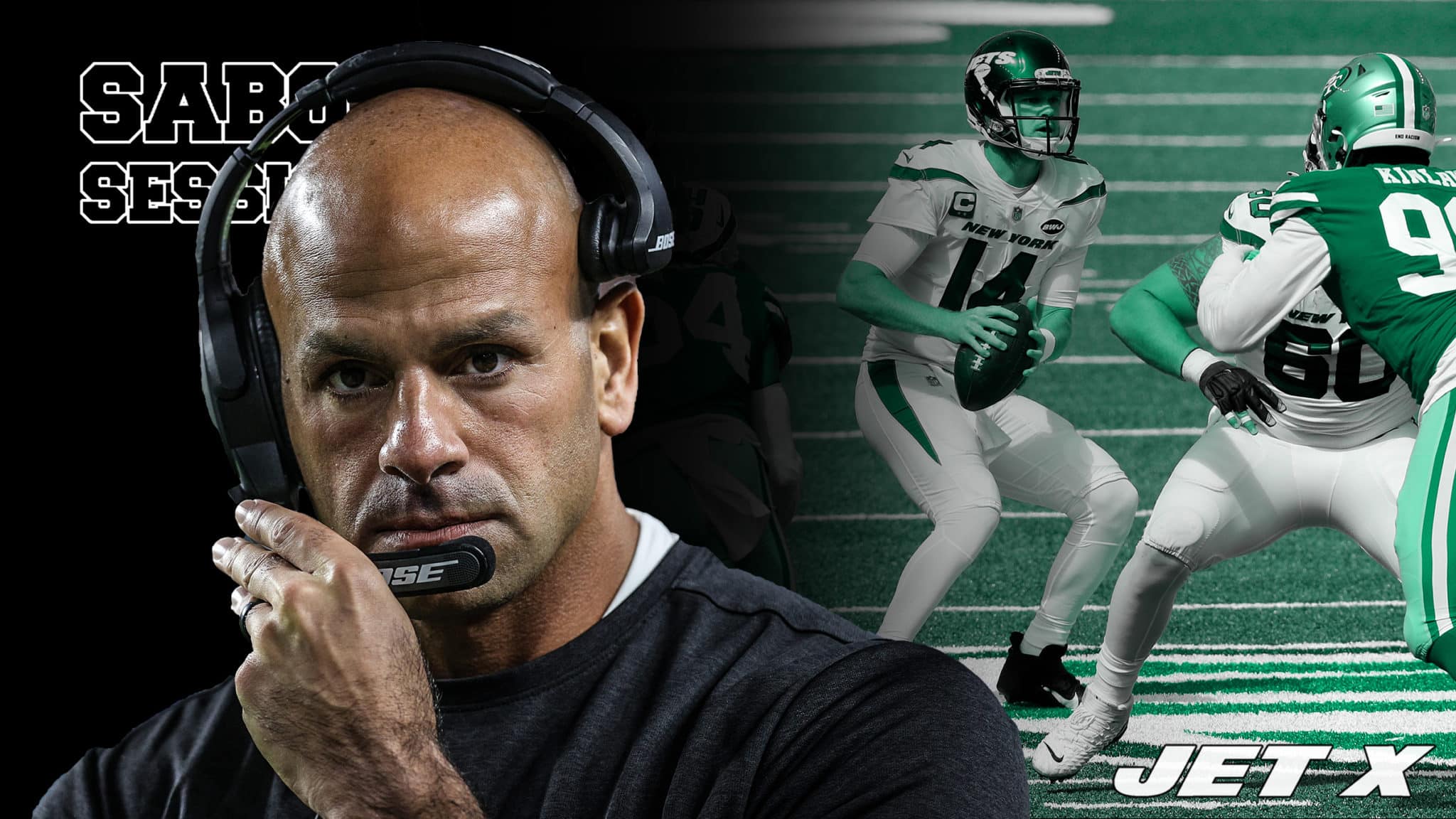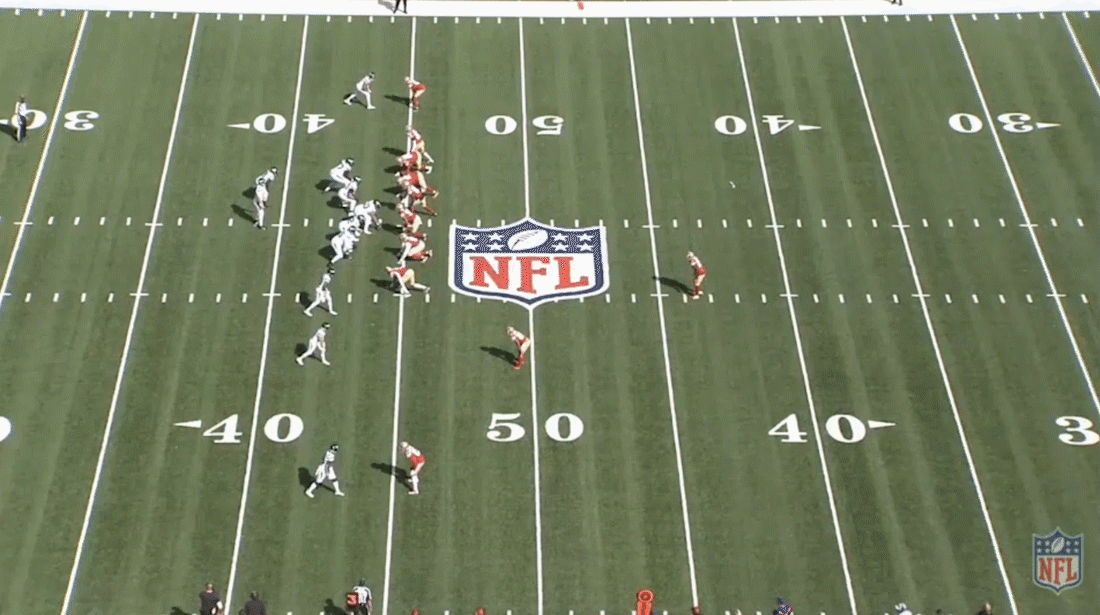Robert Saleh’s suffocating San Francisco 49ers defense easily handled the New York Jets in Week 2 despite key injuries.
Week 2 of this past season was disastrous for the San Francisco 49ers. A 31-13 victory over the New York Jets meant very little. As Robert Saleh recently mentioned publicly, the locker room feel after the victory could only be described as somber.
Richard Sherman and Dee Ford missed the game entirely, but the bad news didn’t end there. Quarterback Jimmy Garoppolo, running back Raheem Mostert, stud edge rusher Nick Bosa and interior defender Solomon Thomas all exited the game via injury. Bosa and Thomas each tore ACLs, meaning Saleh’s defense would be without them for the remainder of the season.
Saleh was forced to adjust. Rather than relying on his conventional pass rush to hit home, he began to ramp up the pressure. He blitzed 33 percent of the time in 2020, placing his defense 10th in the league. With his pass rush the year prior, Saleh blitzed just 20.9 percent of the time, good enough for 29th in the league. (For reference, the Jets ranked fourth in 2019 and sixth in 2020.)
Saleh’s ability to adjust isn’t up for debate, but how did he handle the Jets in Week 2? How did he adjust in-game once Bosa and Thomas exited? Today, we examine Robert Saleh’s defense against a porous Jets offense early in the 2019 season.
Interestingly, Adam Gase‘s Jets offense did a decent job of running the ball on early downs. Mekhi Becton leading the way for the zone scheme allowed Frank Gore to rip off decent chunks. Where the Jets failed is not capitalizing through the air on rushing downs when Saleh was prepared for the run.
The first play of the game featured Gore going for five yards on a duo call against a clear eight-man box. After a first-down completion to Chris Hogan on third-and-5, the Jets are set up at their own 41-yard line. But the third-and-5 play is a perfect example of what Saleh likes to do on third-and-manageable situations.
Saleh often features an overloaded defensive line, if only to use the 1-technique or 2i in order to attract two interior blockers. This allows the other three pass rushers one-on-one looks.
Behind it, Saleh runs a Cover 4 match with a keen sense of awareness on the chains. Cover 4 is Saleh’s prominent coverage. It was also his prominent coverage early in this game while relying on his conventional four-man rush.
On the ensuing play, Adam Gase gets the better of Saleh:
Saleh loves to crash his defensive ends with an edge blitz outside of it. Here, Bosa crashes hard, Braxton Berrios does just enough to handle the run-first cornerback, and the inside split zone picks up seven yards.
Again, the Jets ran well on early downs in the first half. They simply couldn’t take advantage of a defense ready for the run on second-and-manageable.
The Jets threw an incompletion against Saleh’s Cover 6 on second down, setting them up for a third-and-3. Saleh, a man who loves his four-man front, decided to throw a 3-4 principled look at the Jets.
Of course, technically, this is not a true 3-4. San Francisco is still in a nickel against the Jets’ 12 personnel—which is something rarely done by Saleh. If anything, he favors playing heavier than lighter.
The linebacker lined up in the B-gap serves as the 4i defensive tackle in what can easily be viewed as a 3-3-5 front. The run blitz that sent the B-gap linebacker and MIKE shut down the inside zone split.
One defensive possession later, Saleh breaks out a semi-exotic look but gets burned.
Despite the overload nature of the call, technically, it’s not a blitz. Saleh still generated a free-rusher but Sam Darnold completes the out in time.
Four plays later, Saleh had seen enough of the early-down rushing. Gase had run the ball three of four times on first down up to this point, so Saleh broke out a run blitz from a 3-4 look.
It was at this point that Saleh figured out Gase. Come hard on early downs or in obvious run situations and play pass when appropriate. The Jets never adjusted and Saleh always stayed at least one step ahead.
After a long Niners drive that resulted in their second touchdown of the game, Saleh’s team led 14-3. The Jets responded with another decent drive but ultimately faltered in short yardage on both third and fourth down.
Truth be told, there should be more blame on the offensive play-caller than praise for Saleh here. But selling out against the run was the undoubted proper call.
The Niners took a 21-3 halftime lead into the locker room but had already lost Bosa and Thomas defensively. On the Jets’ first possession, naturally, Gase runs it on first down for four yards. San Fran stops it after four yards without a run blitz.
On third-and-3, Saleh goes to a double-A-gap look without Bosa and Thomas in the game.
As stated at the top, the difference in blitz rates between 2019 and 2020 was drastic. This play perfectly showcases how Saleh approached things without his top pass rushers in the mix.
On the next third-down opportunity (next possession), Saleh goes back to the well. Only this time, he overloads it.
The Niners defense transformed before our very eyes in Week 2, courtesy of the Bosa and Thomas injuries.
Early in the fourth quarter, a Saleh coaching point hits home. Watch the slot defender’s route to his zone.
Notice his depth. Routinely, a curl-flat defender in a Cover 3 will get lost shallow. Here, the safety understands his reads and realizes that there isn’t a third read that’s threatening him shallow.
So he gets depth and allows the linebacker to appropriately take his “first man out of the backfield” responsibility. Immediately getting that depth snuffs out the scissors concept (the post is meant to clear the deep-third cornerback zone for the slot corner to get open).
Two plays later, on third down, Saleh continues the trend. Despite holding a commanding 24-6 lead in the fourth quarter, Saleh goes with another double-A-gap look with a six-man rush.
One A-gap linebacker rushes while the other drops. No prevent defense in this situation. No soft coverages here.
On the next defensive possession, Saleh’s first-down readiness against the run remains evident.
The Jets really squandered one in this game. Mekhi Becton and the offensive line played extremely well, especially when running the ball on early downs. Not taking advantage of that situation is a football crime of the highest order—especially in today’s pass-happy league.
Saleh didn’t run-blitz on this down, but it’s apparent that his linebackers are ready for a run attempt. Each is on the balls of his feet and amped up to lean forward. It’s exactly the situation that calls for play-action.
A little later, Saleh comes with the pressure yet again on third down.
Against a three-man route (with a late release by the tight end coming out of the backfield), the Niners defense has it easy. Roll with man on the outside as each cornerback can use the sideline and bracket the slot weapon with the slot corner and one of the safeties.
Finally, Saleh showcases a Cover 1 Robber that completely takes the Jets out of what they want to do.
Saleh will often start two-high only to drive one safety down in a Cover 3 or Cover 1 Robber look.
The Jets mustered just 277 total yards in the game, and there’s no question a lot of that should be pinned on the team’s offensive game plan rather than the Niners’ brilliance.
Nonetheless, this game perfectly exemplifies how now-Jets head coach Robert Saleh adjusts. Instead of bland coverages with a four-man pass rush reliance, he started to run-blitz on early downs and throw in exotics pressures on third down.
Knowing he had to adjust after losing Nick Bosa and Solomon Thomas, Saleh not only accomplished his goal over the course of the season, but he also got it done in Week 2 against the New York Jets.







